Bestoutcome has previously published a white paper giving an overview of developing business cases for Portfolio, Programme, and Project Management (PPPM) systems.
In this second paper, there is a particular focus on content guidance for developing business cases in the public sector.
Increasing demand for public services creates even more pressure on the available and future public resources, with stricter requirements to make better use of these limited resources.
The challenge to those preparing and advising on spending decisions has never been greater. In this context, it is vital that spending and investment decisions are based on highly competent professionally developed proposals.
The UK Office for Government Commerce (OGC) published Best Practice Guidance and draft templates in the period 2008-2010, and the various national Treasuries and devolved Governments have developed and published their own versions based on the original OGC Green Book.
These versions have been refined and tested over many years and provide clear frameworks for thinking about spending proposals.
They also outline structured processes for appraising, developing, and planning to deliver the best social value for money: all of which should be captured through well prepared business cases to support objective, evidence-based decisions.
The requirements for organisational effectiveness in the public sector can be broadly grouped into the following themes:
As part of its guidance the OGC set out a framework for business case content which is often referred to as “the 5-cases model”.
The model lays out a recommended standard for the preparation of business cases and is used extensively within central government departments and the public sector. The five elements of the model are:
Depending on the scope, scale, and value of the proposed investment some or all elements may be included in a typical business case template.
Layouts and emphasis may differ, however, the basic information required to enable decision making remain similar.
Each of these five elements is explored in more detail below, with an emphasis on providing information, context, or questions to help PMOs and Senior Managers with creating successful business cases for the procurement of Portfolio, Programme, and Project Management (PPM) systems such as Bestoutcome’s PM3.
For each of the 5 business case elements examples of statements have been provided. These are based on a fictitious public sector organisation with the following characteristics:
The organisation is medium sized with circa 4000 staff. Each year has a recurring cycle of cost improvement programmes with up to 120 schemes per year. In addition, there are 20-30 service improvement and quality improvement projects per year. The 3-year operating plan includes a multi-organisation partnership to deliver joint projects under the auspices of a steering committee with members from all organisations.
(a) Pioneering user-centered services with exceptional outcomes and excellent user experience.
(b) Being at the leading edge of research, making new discoveries with our partners and service users.
(c) Driving innovation through sharing knowledge and developing tomorrow’s experts.
(d) Key collaborators to shape national policy.
(e) Operating an infrastructure and culture that supports innovation.
(f) Having a sustainable financial model.
(g) Delivering benefits in efficiency and effectiveness through partnership working across the local economy.
(a) There is a small PMO team with dual roles of both Programme Office and Programme delivery.
(b) Project and programme management, reporting and governance are based on a manual process using MS Excel spreadsheets, workbooks and macros.
(c) There are evolving and increasing reporting requirements for multiple stakeholders
(d) Projects and programmes are managed by a mix of experienced interim PPM professionals and in-house employees with varied PPM experience and skills.
When reviewing the business case templates from several public sector users of PM3 the most common areas covered in the strategic case section included:
How does the proposal align to the strategic needs of the organisation?
The organisation is driving forward a complex improvement and efficiency programme for the next 3-year business cycle.
A key programme over this period with be the cost and internal efficiency improvement programme to deliver £ 15 mill. of benefits.
A second programme will be focused on the re-investment of £5 mill of the efficiency benefits into service improvement projects.
Three stated strategic imperatives for the organisation are:
(1) Operating an infrastructure and culture that supports innovation.
(2) Having a sustainable financial model.
(3) Delivering benefits in efficiency and effectiveness through partnership working across the local economy.
The intention is to move from the current manual programme and project management system (PPM) to a cloud-based software solution.
This will deliver a more reliable and consistent operating model for the management and governance of change delivery, improve tracking of both financial and non-financial benefit realisation, and also support coordination of multi- partner projects and reporting requirements through the ability to link projects to multiple reporting portfolios.
Although the organisation has been reasonably successful with past efficiency schemes, the inability to identify and action slippage early in the change delivery processes has led to management and organisational challenges, particularly for realising the benefits from the cost and internal efficiency improvement programme.
The scope and scale of the required programmes will also require a sophisticated level of reporting and oversight to meet the information needs of multiple stakeholders and the Board.
An independent external review of the current MS Excel manual project tracking and reporting system has identified operational and programme governance shortfalls which cannot be addressed with the current capabilities of the MS Office suite software.
The requirement to manage and report on the 20 system-wide projects running in the next year with the partnership organisations creates a requirement for a new and innovative approach to PPM in the organisation.
It is planned that the organisation will have a minimum of 25 staff in programme and project management roles within the next 3 months to deliver the agreed scope of project work described in the 3-year business plan.
The organisation has a small PMO team, with dual roles of both Programme Office and Programme delivery.
Projects and programmes are managed on a day to day basis by in- house employees with varied PPM experience and skills.
Project and Programme Manager resources are supplemented by experienced interim PPM professionals.
The current project and programme management, reporting and governance are based on a manual process using MS Excel spreadsheets, workbooks and macros.
The MS Excel functionality is limited in its capacity to handle a large number of projects.
The spreadsheet system has also been shown to have a high risk of data input error and double counting of costs and benefits.
These tend to occur when individual project reports are manually collated into programme updates for the Board and related committees.
This has resulted in significant PMO and Project Manager resource required to recheck and rework inputs and report outputs. There are evolving and increasing reporting requirements for multiple stakeholders.
A time and motion study has shown that each project manager spends an average of 2 days per month on updating spreadsheets and document rework to enable the PMO to collate and present up-to-date status reports to the Executive and other Boards.
Investing in a PPM software system will enable a step change in the organisation’s ability to manage delivery, report on progress and evidence robust governance and oversight for programmes of change.
Deployment of a new system will also support skill and knowledge development for internal PMs, underpinning the strategic imperative to operate an infrastructure and culture that supports innovation.
(a) Standardise the approach to programme and project management
(b) Establish an objective, consistent project status reporting structure
(c) Significantly reduce the risks and resource drain associated with error-prone manual reporting
(d) Clarify and increase the ability to monitor project benefits after go-live
(e) Maintain a central repository for all project documents required for both monitoring and governance purposes
(f) Build a clear line of sight for managing inter-project and intra-programme dependencies
(g) Provide for Project Managers an easy-to-use tool to plan delivery, manage teams and coordinate tasks and actions linked to milestone achievement and benefit realisation.
(h) Operate a one version of the truth model through a consistent, automated project reporting tool
As recommended in the Standing Financial Instructions three options have been evaluated.
(1) Do nothing – the existing status quo and manual processes for managing programmes and projects remain unchanged, with the resulting negative impact on both PMO and Project resource costs to support the increase scope and scale of change required.
(2) Procure a standalone PPM system (System X) which is hosted internally on the organisations servers through a full competitive tender process, accepting the risks associated with procuring implementing system upgrade through the product life cycle of the software.
(3) Procure a cloud-based PPM system, which might only require a short mini-tender process with a limited number of specialist service providers.
Option 3, the PM3 system from Bestoutcome, is the preferred option for the proposal.
This cloud-based software option will be able to support a regular cycle of remote system upgrades which will enable our PMO processes to remain near to the leading edge of PPM system development.
Included is the use of a mobile device application to allow the project teams to do real-time updates on actions, tasks and risk status.
The forecast ROI period is 5-6 months after go-live.
Although these will be unique to each organisation an example based on a real client scenario has been given below.
There will be a dependency on the external timeline for the establishment of a PMO to deliver a procurement process and criteria for a PPM system for the management of multi-partner programmes implementing across the local economy.
The preferred option (PM3) has the capability to host system level programmes and projects.
It can scale up quickly, linking projects to multiple portfolios to enable reporting for multiple partner Boards and SROs.
Using this option will eliminate the need for further time-consuming procurement processes, thereby reducing the set-up time for the joint PMO and programmes.
The purpose of showing the economic case is to establish the relative Value for Money (VfM) for a given investment.
Most organisations will have a local Financial Appraisal Model where financial and activity data should be provided, with summary, explanation and other relevant matters provided as narrative in this section.
Depending on the value of the investment or anticipated revenue cost the case may be required to compare the economic implications of at least three options, including a ‘do nothing’ scenario and some form of sensitivity analysis.
For the purposes of this example we have provided a description and evaluation of the preferred Option 3, a cloud-based PPM system.
In this case we have evaluated Bestoutcome’s PM3 system to give a degree of realism to some statements.
Evaluation of any other options would follow a similar structure to allow sufficient evaluation and challenge before the preferred option is confirmed.
PM3 is a cloud-based ‘ready-to-go’ portfolio project management solution.
It was launched in 2007 and was developed by experienced programme and project practitioners.
The system is designed to help PMOs and users focus on outcomes and benefits, ensuring that project teams maintain focus on delivering the change.
The system is used by private and public sector organisations, with a strong presence across the NHS.
The PM3 Data Centre is in Reading, UK. It is fully manned 24x7x365, and is a secure server environment with security systems including perimeter vibration sensors, CCTV and fire suppression systems.
During the evaluation of PM3 the following potential benefits were identified:
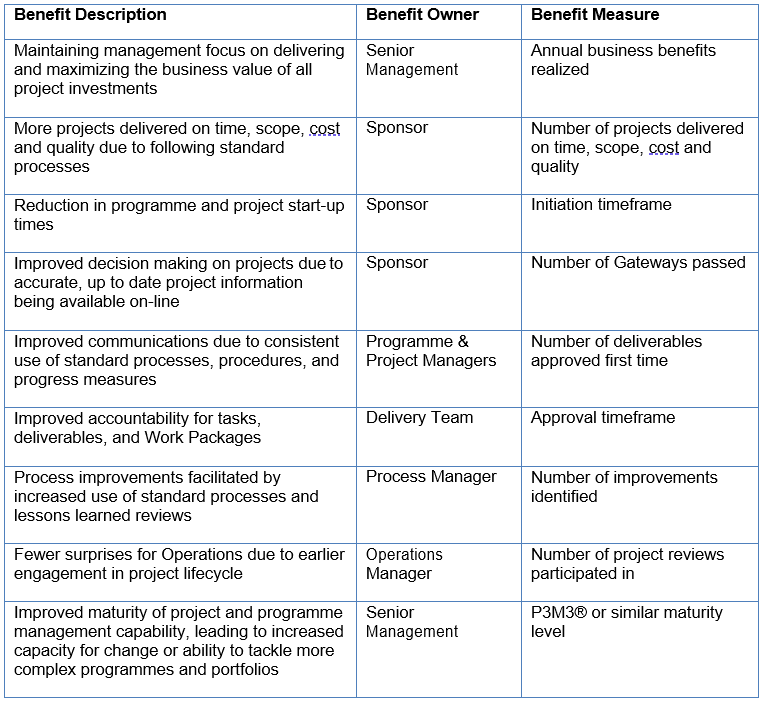
The evaluation team also looked at PM3 from a user and stakeholder perspective and the following points were highlighted.
An easy-to-use tool to collect all project documentation
A consistent, automated project reporting tool
A mobile application (Android and IOS) to enable real time monitoring of assigned tasks and actions, and the ability to provide updates without the need to log-in and access the system via a PC or laptop.
The return on investment has been calculated based on the following assumptions:
The total Year 1 costs (excluding VAT) are shown in Table 1 below.
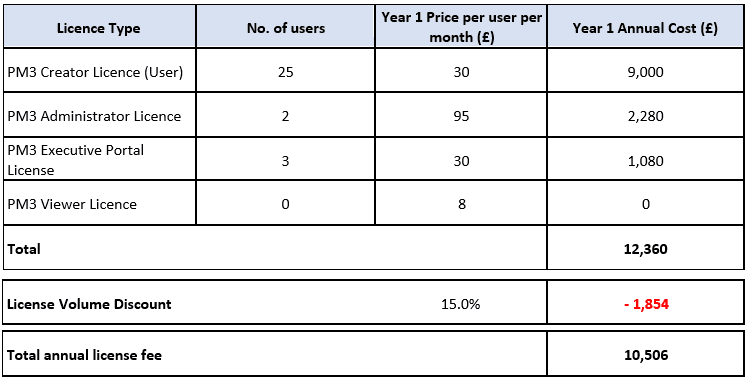
Years 2 and 3 will incur the license fee cost only. The total PM3 license cost over the 3- year contract period will be £ 33 000.
Note: With the forecast increase in programme and project activity “Option 1: Do nothing” would require the recruitment of 2 additional PMO analysts at pay band 4.
Therefore, the Do Nothing option would incur a £76 000 cost over the same 3-year period, with no anticipated return on the investment.
Additional installation and training costs for PM3 are incurred in Year 1 only, and these are shown in Table 2. The total 3-year cost of the system is £41 000.
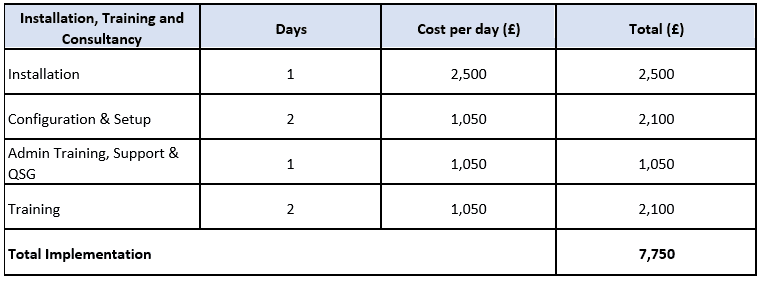
Using a standard ROI calculation model, the anticipated payback period will be 5 months after go-live.
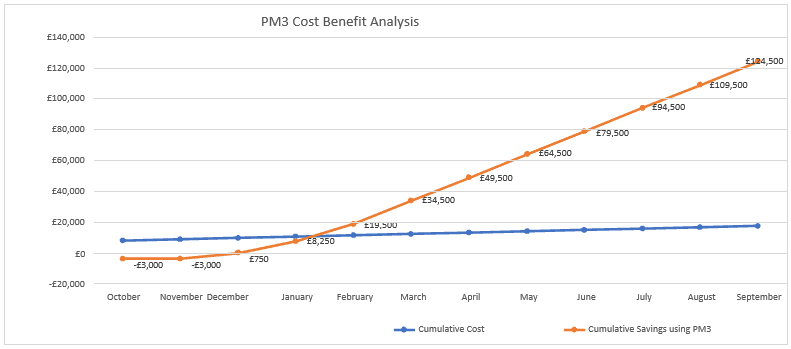
With PM3 installed there may well be the opportunity to reduce the number of MS Project licenses, potentially making further savings not included in the ROI modelling.
This section outlines the procurement strategy for delivery of the project. The value of the contract described in the economic case may determine which procurement route is chosen.
The options that are normally considered are:
Selection of PM3 as the preferred system has followed a User/PMO team evaluation of 3 similar systems from different providers.
All systems were evaluated against a set of criteria derived from user and PMO requirements from a PPM system.
A senior nominated representative from the IT function was part of the evaluation process to ensure that any system met the minimum requirements for data and information security.
A discount of 15% has been applied to the license fee as the first discount threshold of 25 licenses has been proposed.
Further discounts are available should the organisation decide to procure more licenses.
Discount thresholds are specified on the framework and in the relevant schedules of the contract document.
License fees are paid yearly in advanced. The payment schedule is based on the contract anniversary date.
All other terms and conditions are determined by terms and conditions (T&C) of the contract.
The contract will be reviewed by the Head of Procurement before proceeding.
The finance case provides explanation of the implication to the finances of the organisation in order to provide understanding of the ongoing affordability of the project, including clearly the affordability of each option.
“With the forecast increase in programme and project activity “Option 1: Do nothing” would require the recruitment of 2 additional PMO analysts at pay band 4. Therefore the “Do nothing” option would incur a £76 000 cost over the same 3-year period, with no anticipated return on the investment.
Option 2: Procure a standalone PPM system (System X) carries a significant risk in terms of hidden costs for system development and upgrades.
The system will also have a high dependency on supplier expertise as the localisation is driven and configured entirely by the supplier, with little or no skill transfer to the organisation.
Any organisation developments to other associated IT software and hardware may have cost implications as the suppliers will need to be contracted in to ensure that any system compatibility issues can be identified and actioned.
Option 3: PM3 has a 3-year revenue cost of £41 000 with 25 user licenses for project managers. The licenses will be funded from the PMO operating budget.
The current budget allocation would need to be increased to cover the planned license costs per year.
Set-up and installation costs will be funded from the current contingency funds available to the Directorate of Strategy and Service Development.
As a cloud-based system PM3 will allow easy expansion to include partner organisations.
The only additional costs will be to procure any additional licenses, and partners will just need have the capability to access the system through an internet browser.
Partner license costs would be recovered under the terms of any Memorandum of Understanding or formal contractual arrangements.
The procurement of any additional licenses over the 3-year period will be governed and approved through the normal revenue funded procurement process, with executive authorisation required in order to proceed with roll-out and system expansion”
The final consideration is the management case which identifies the processes and structures that will support the delivery of the project.
The governance structure for the project will be managed through the Director of Strategy and Service Development. The director will provide monthly updates to the organisations Executive Team.
The SRO for the project will be the Head of PMO, and the operational day-to-day management structure for the project will run through the PMO team with a senior analyst being allocated a system Administrator license.
The SRO will be accountable for the delivery of the project within the agreed timescale of full deployment go-live intended for 3 months after contract award.
The day to day decision-making responsibility will be with the SRO, however weekly reporting to the Director of Strategy will include any pending decisions or diversions from plan to ensure that they are consistent with the overall strategic direction of the organisation.
Any risks and issues arising from the implementation will be assessed against the organisations Risk policy and escalated as required.
The time period for the installation, set-up and customisation of the system is anticipated to be 3 months from contract date.
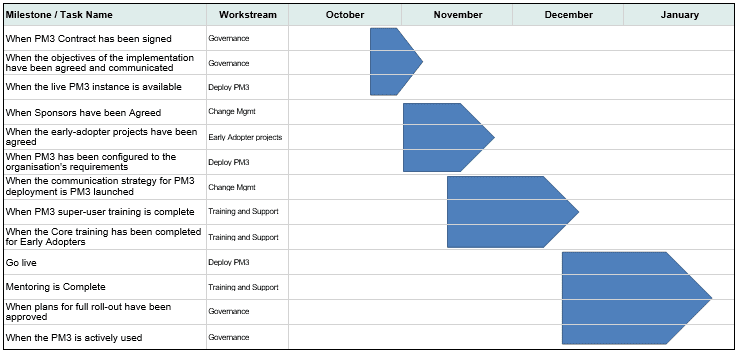
During the implementation period there will be a degree of double running for programme and project reporting as existing projects are transferred into the new system. Processes have been put in place to cover this short-term increase in PMO activity.
6 months after approval is given the Head of the PMO will present a benefits realisation of the case to the Business Case Review Group.
The purpose of this step will be to ensure that the deliverables within the original case are being met as originally outlined.
If this is not the case, or if there is evidence that the case has not progressed, the Group will have the authority to refer the case to the Management Executive.
As stated in our previous paper a PPM system will help senior management answer strategic questions like “are we still doing the right projects?” and “are we still doing them right?”, however the decision to invest in a PPM system or other tools always needs to be supported by a compelling Business Case.
We have many public sector clients who have followed the business case structure described in this White Paper and who have achieved a significant ROI and a payback of less than 9 months when implementing our own project portfolio management tool PM3.
If you would like advice on building a compelling Business Case for implementing PPM tools in your organization, or more information on PM3, please contact us at info@bestoutcome.com .

Our products help you deliver successful change programmes and projects by always focusing on the overall business outcomes. Find out how our products can help you.
Tell me more Request a demoA common theme throughout many of my blogs has been the focus on outcomes and why this is critical t...
Read more >This paper focuses on content guidance for developing business cases in the public sector....
Read more >Here you will find how RAGs play a crucial role in both project reporting and organizational leaders...
Read more >